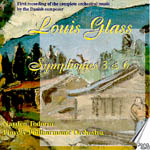Danish composer Louis Glass (1864-1936) enjoyed modest success in his lifetime, even in the shadow of his more famous compatriot Carl Nielsen. Compared to the progressive and innovative Nielsen, Glass sounds strikingly conservative and old-fashioned, an impression that led to the decline in his career near the end of his life. A self-confessed “dreamer”, Glass creates music that luxuriates in rich, late-romantic harmonies and modes of expression, and while it may not be especially challenging intellectually, it always pleases by virtue of its conventional beauty. Symphony No. 3 (1901) is a case in point. Composed a year before Mahler’s path-breaking Fifth Symphony, it occupies a sound-world similar to Humperdinck’s Hansel and Gretel, with a first movement main theme who’s harmonic contour brings to mind the old “My Favorite Martian” TV theme. The subtitle “Wood Symphony” refers not to planks or boards, but to the scherzo’s woodland meadow in which Glass’ imaginary protagonist finds himself lost. The big, dramatic finale explores even more sounds and moods of the forest before concluding with a triumphant reprise of the first movement’s main theme.
Symphony No. 6 (1924) was Glass’ last, and it’s apparent that during the years following the Third Symphony Glass developed a more advanced, if still not modernist, compositional technique. The old romantic colors and gestures are in place, but now they are informed by contact with the music of Stravinsky (among others), whose influence is discernible in the short scherzo’s canonic writing. Glass was inspired by Ingemann’s poem “Valdemar the Great and his men” (from which comes the subtitle “Birth of Scyldings”), and he composed an appropriately majestic and far-flung (five movements) symphony to represent it. As in No. 3, the finale closes affirmatively with a restatement of the first-movement theme.
It’s clear that conductor Nayden Todorov believes in Glass’ music and he gets committed playing from the Plovdiv Philharmonic Orchestra. But the ensemble’s occasional imprecision and lack of rhythmic alacrity makes you wonder how these works would sound if played by a superior band like the Danish Radio Symphony (or even the neighboring Gothenburg Symphony). Danacord’s opaque recording doesn’t let the music ring the way I suspect it should. But, for now at least, this release is what we have of these two Glass symphonies, and adventurous collectors need not hesitate in making its acquaintance.
































